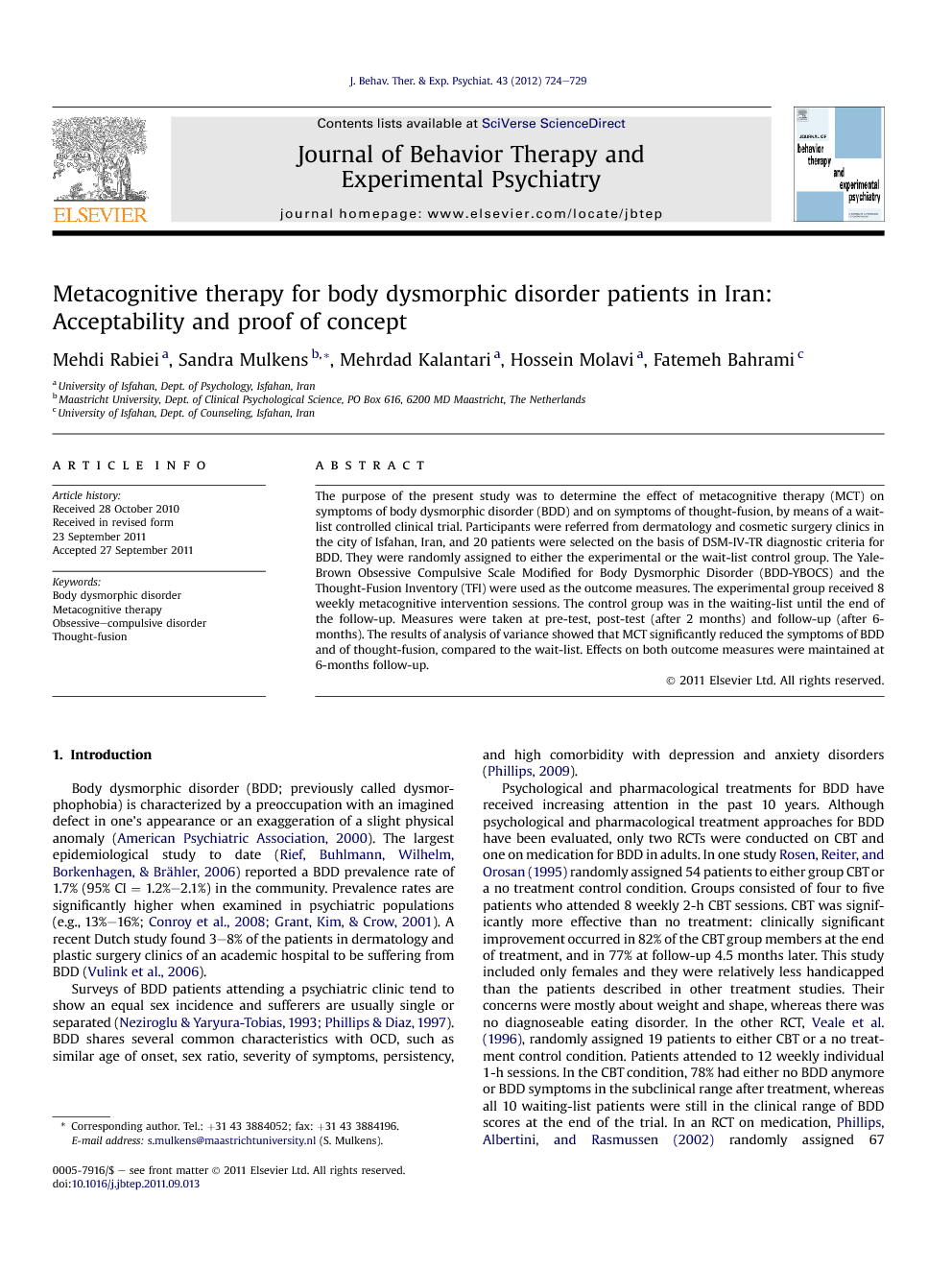The purpose of the present study was to determine the effect of metacognitive therapy (MCT) on symptoms of body dysmorphic disorder (BDD) and on symptoms of thought-fusion, by means of a wait-list controlled clinical trial. Participants were referred from dermatology and cosmetic surgery clinics in the city of Isfahan, Iran, and 20 patients were selected on the basis of DSM-IV-TR diagnostic criteria for BDD. They were randomly assigned to either the experimental or the wait-list control group. The Yale-Brown Obsessive Compulsive Scale Modified for Body Dysmorphic Disorder (BDD-YBOCS) and the Thought-Fusion Inventory (TFI) were used as the outcome measures. The experimental group received 8 weekly metacognitive intervention sessions. The control group was in the waiting-list until the end of the follow-up. Measures were taken at pre-test, post-test (after 2 months) and follow-up (after 6-months). The results of analysis of variance showed that MCT significantly reduced the symptoms of BDD and of thought-fusion, compared to the wait-list. Effects on both outcome measures were maintained at 6-months follow-up.
Body dysmorphic disorder (BDD; previously called dysmorphophobia) is characterized by a preoccupation with an imagined defect in one’s appearance or an exaggeration of a slight physical anomaly (American Psychiatric Association, 2000). The largest epidemiological study to date (Rief, Buhlmann, Wilhelm, Borkenhagen, & Brähler, 2006) reported a BDD prevalence rate of 1.7% (95% CI = 1.2%–2.1%) in the community. Prevalence rates are significantly higher when examined in psychiatric populations (e.g., 13%–16%; Conroy et al., 2008 and Grant et al., 2001). A recent Dutch study found 3–8% of the patients in dermatology and plastic surgery clinics of an academic hospital to be suffering from BDD (Vulink et al., 2006).
Surveys of BDD patients attending a psychiatric clinic tend to show an equal sex incidence and sufferers are usually single or separated (Neziroglu and Yaryura-Tobias, 1993 and Phillips and Diaz, 1997). BDD shares several common characteristics with OCD, such as similar age of onset, sex ratio, severity of symptoms, persistency, and high comorbidity with depression and anxiety disorders (Phillips, 2009).
Psychological and pharmacological treatments for BDD have received increasing attention in the past 10 years. Although psychological and pharmacological treatment approaches for BDD have been evaluated, only two RCTs were conducted on CBT and one on medication for BDD in adults. In one study Rosen, Reiter, and Orosan (1995) randomly assigned 54 patients to either group CBT or a no treatment control condition. Groups consisted of four to five patients who attended 8 weekly 2-h CBT sessions. CBT was significantly more effective than no treatment: clinically significant improvement occurred in 82% of the CBT group members at the end of treatment, and in 77% at follow-up 4.5 months later. This study included only females and they were relatively less handicapped than the patients described in other treatment studies. Their concerns were mostly about weight and shape, whereas there was no diagnoseable eating disorder. In the other RCT, Veale et al. (1996), randomly assigned 19 patients to either CBT or a no treatment control condition. Patients attended to 12 weekly individual 1-h sessions. In the CBT condition, 78% had either no BDD anymore or BDD symptoms in the subclinical range after treatment, whereas all 10 waiting-list patients were still in the clinical range of BDD scores at the end of the trial. In an RCT on medication, Phillips, Albertini, and Rasmussen (2002) randomly assigned 67 individuals to either 12 weeks of Fluoxetine or a placebo. Fluoxetine was superior to placebo. To summarize, evidence of CBT as a favorable treatment for BDD is still scarce and no RCT has directly compared CBT to medication yet.


